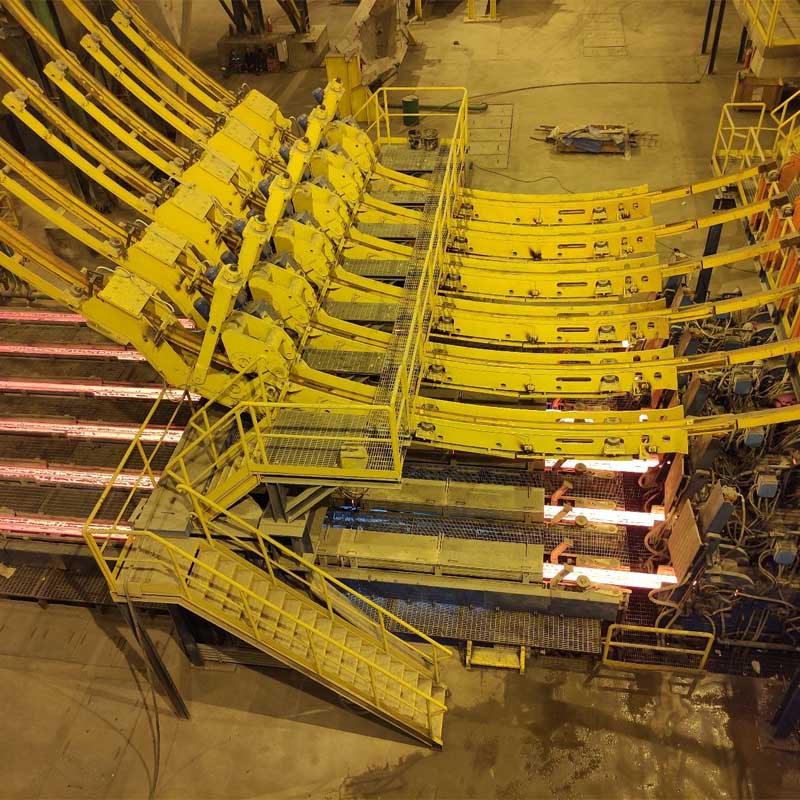Description
Dummy Bar
The dummy bar is one of the important devices for continuous casting and ironmaking. The flexible dummy bars and rigid dummy bars is composed of a dummy head, dummy bar transition piece, and dummy body.
Before pouring, the dummy head and some transition parts enter the mold to form a movable “inner bottom” of the crystallizer. After pouring, the molten steel solidifies and condenses with the dummy head.
The dummy bar is pulled by the withdrawal straightener to continuously pull the slab out of the crystallizer until the dummy head is separated from the slab through the rear of the withdrawal straightener and enters the dummy bar storage device.
The function of the dummy bar is driven by the driving device in the dummy bar storage device from the dummy bar storage position, through the withdrawal straightener, and then driven by the withdrawal straightener, and sent to the lower opening of the crystallizer copper pipe through the slab guide section and secondary cooling device.
During casting, the billet is led out from the crystallizer copper pipe. The driving force generated by the withdrawal straightener is used to drive the billet from the secondary cooling device and the billet guide section into the withdrawal straightener.
When the dummy bar comes out of the withdrawal straightener, it will leave the billet under the function of the withdrawal straightener and enter the dummy bar storage device to wait for the next work.
The Rigid dummy bar or flexible dummy bar can be selected according to different user requirements.
Function
Since the crystallizer is a “bottomless ingot mold”, the dummy head at the upper end of the dummy bar device must be extended into the crystallizer as the movable bottom of the crystallizer before pouring. The tail end of the dummy device is still clamped in the pull roller of the withdrawal straightener.
After pouring, with the solidification of liquid steel, the billet and dummy head condense into one and are pulled out by the pull roller.
After the dummy head passes through the pull roller, the dummy device is separated from the billet and sent away for the next pouring.
Hani metallurgy provides flexible dummy bars and rigid dummy bars.
The flexible dummy bar is used in various continuous casting and rolling mills, and its dummy body is composed of dozens of chain links.
The rigid dummy bar is only used for billet continuous casting and rolling mill. The early rigid dummy bar body is an arc-shaped steel structure. Now it has been made into several arc sections and connected with bolts.
This rigid dummy bar is more flexible and convenient to insert into the crystallizer, and also brings convenience to the manufacture and transportation of dummy bar.
The rigid dummy bar is adopted, and the billet guide device of the continuous caster does not need to be equipped with many rollers to guide the dummy bar so that the pouring can be started smoothly.
Another great advantage of using a rigid dummy bar is that the time of reinserting the dummy bar is greatly shortened and the operation rate of the caster is improved.
The dummy bar is one of the special equipment of a continuous casting machine. In order to meet the requirements of passing through arc space with different radius, it adopts a short pitch chain structure and one-way bending. Each chain link is connected with a pin shaft, and a stop is set at the tail of both ends of the chain link to prevent reverse bending.
Parameter
Determination of Design Parameters of Dummy Bar
(1) Dummy bar length
The length of the dummy bar is the sum of the length from the conveying chain hook of the dummy bar car in the horizontal position to the dummy head into the crystallizer and the arc length from the position of the dummy head into the crystallizer to the first pair of driving rollers, plus 300 ~ 500 mm.
(2) Thickness of dummy bar body
The thickness of the dummy bar body can be determined according to the minimum billet thickness. The thickness of the dummy bar body is slightly less than the minimum slab thickness.
(3) Pitch of dummy bar link
The pitch of the dummy bar chain link can be determined according to the roll row of the general layout, and the roll pitch that can pass through the sector section is the principle, which is generally 400-500 mm. The link distance of the billet is 420 mm.
(4) The section shape of the dummy head during automatic ingot removal has the following characteristics:
1) Easy to process;
2) Easy to take off ingot with minimum force;
3) Heat evenly to avoid sticking
Service
We can provide foundation layout and layout drawings
We will send engineers to your factory to install and debug machines and provide reliable after-sales service.
Competitive price and excellent quality
Our machines are easy to operate and maintain
Less investment
Stable performance
Products can be customized according to different needs
Production capacity can be adjusted according to customer requirements
Low energy consumption
























Reviews
There are no reviews yet.